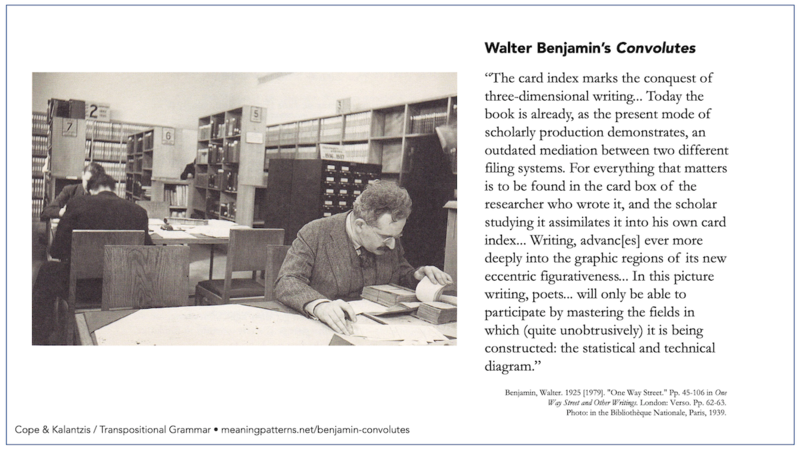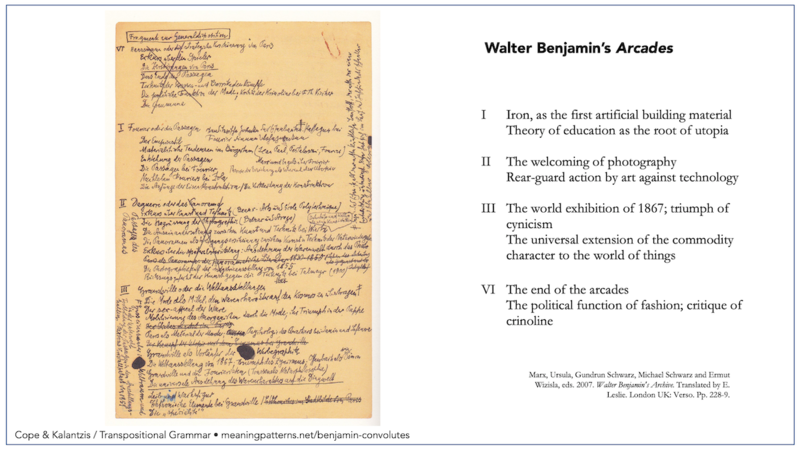Meaning Patterns’s Updates
Walter Benjamin’s Convolutes
In this book, we’re going to look at things whose meanings are at times so ordinary that they tend to disappear from sight. “Quotidian” is the word we like – mundane, unexceptional, but also omnipresent, dependable.
A: Arcades
B: Fashion
D: Boredom
F. Iron Construction
O: Gambling
P: The Streets of Paris
R: Mirrors
U: Railroads
V: Conspiracies
Y: Photography21
These are some quotidian things mentioned in the index to thirty-something folders of notes on cards by a man who had been spending his days in the Bibliothèque Nationale in Paris – reading, copying quotations onto cards, taking down references and writing down ideas as they sprang to his mind. Walter Benjamin,* German Jewish writer and intellectual, had fled from Berlin to Paris in 1933 when the Nazis came to power.
The card index marks the conquest of three-dimensional writing … Today the book is already, as the present mode of scholarly production demonstrates, an outdated mediation between two different filing systems. For everything that matters is to be found in the card box of the researcher who wrote it, and the scholar studying it assimilates it into his own card index … Writing, advanc[es] ever more deeply into the graphic regions of its new eccentric figurativeness … In this picture writing, poets … will only be able to participate by mastering the fields in which (quite unobtrusively) it is being constructed: the statistical and technical diagram.22
Benjamin’s project was to write a book that may have been called, had it been completed and published, Paris: Capital of the Nineteenth Century. This is the title he gave to two summaries he sent to his project sponsors, Theodor Adorno§AS1.4.2b and Max Horkheimer – Jewish intellectual friends from the School for Social Research in Frankfurt. They had already left Germany and joined the New School for Social Research in New York, the “University in Exile.”
In his notes and communications, Benjamin called this work the “Arcades Project.” The shopping arcade was a key motif in his evocation of nineteenth-century Paris, glass-roofed pedestrian streets, bristling with the allure of commodities artfully laid out in the shop windows, window shoppers casually passing by, imagining what they might buy, or imagining themselves with what they might not be able to buy. As the research went on, the folders of notes grew thicker.23
Each of these folders, Adorno later gave the German word Konvolut – a sheaf or a bundle. The editors of the English language translation created the word “convolute” to name these bundles, “as the most evocative term for designating the elaborately intertwined collections of ‘notes and materials’.”24 “Convolute A: Arcades,” then thirty-five more.
The plan for the work was sorted into several iterations. Two project summaries were written. Here are some ideas in a 1935 project summary:
I
Iron, as the first artificial building material
Theory of education as the root of utopiaII
The welcoming of photography
Rear-guard action by art against technologyIII
The world exhibition of 1867; triumph of cynicism
The universal extension of the commodity character to the world of things …VI
The end of the arcades
The political function of fashion; critique of crinoline25
Then, in the summer of 1940, the Nazis invaded France and entered Paris. Benjamin’s friends in New York had arranged an entry visa to the US, wanting him to join them at their University in Exile. He headed to the Spanish border. There he and some other exiles, including a Mrs. Gurland and her son, found people who could show them a path over the Pyrenees.
Lisa Fittko tells “The Story of Old Benjamin,” though he wasn’t old. He was 48.
I do remember everything that happened; I think I do … Is it possible to step back into those times when there was no time for remembering what normal life was like, those days when we adapted to chaos and struggled for survival?
Mrs. Gurland’s son, José – he was about fifteen years old – and I took turns carrying the black bag; it was awfully heavy … Old Benjamin: under no circumstances would he part with his ballast, that black bag; we would have to drag the monster across the mountain … José and I took him between us; with his arms on our shoulders, we dragged him and the bag up the hill. He breathed heavily, yet he made no complaint, not even a sigh. He only kept squinting in the direction of the black bag …
We passed a puddle. The water was greenish slimy and stank. Benjamin knelt down to drink.
“You can’t drink this water,” I said, “it is filthy and contaminated.” …
“I do apologize,” Benjamin said, “but I have no choice. If I do not drink, I might not be able to continue to the end.” …
“Listen to me,” I said, “ … You will get typhus”.
“True, I might. But don’t you see, the worst that can happen is that I can die of typhus AFTER crossing the border. The Gestapo won’t be able to get me, and the manuscript will be safe.”26
When the Spanish border post came into sight in the valley below, Lisa Fittko turned back and Benjamin walked on to the border with the others in the small party.
New orders from Madrid, the border guards said, no entry to Spain without a French exit visa, the group was to be sent back to France. That night, Benjamin took an overdose of morphine. The next day, shaken by the death, the guards let the rest of Benjamin’s party through.
No bag, no manuscript was found. Gershom Scholem, Benjamin’s closest friend, said (ambiguously, contradictorily), “There is no manuscript … Until now, nobody knew such a manuscript existed.”27
We’re interested in the materiality of text, as well as what it said, or might have said. There was something more ordinarily weighty in this bag, if there was a bag. Meanwhile, to keep them from falling into the hands of the Gestapo, librarian Georges Bataille hid the convolutes away in the Bibliothèque Nationale.28 Adorno brought them to New York in 1947.
***
Walter Benjamin’s Arcades project§0b is richly evocative, not only for its explorations of the materiality of streets and buildings and shopping and commodities in the iconic city of the nineteenth century, but also for its intricate material formlessness. From these quotidian raw materials, Benjamin was going to shape a philosophical history of modernity. Each object, so ordinary, was to illuminate deeper meanings. However, we are left today to read a book that does not exist. Benjamin left a kind of a ruin, a miniature version of the ruin of Europe left by his nemesis, the Nazis.
This is how we have been left to decipher the bundles of notes. They are a fertile place to imagine what Benjamin’s masterwork may have said. We read the summary and the categories of classification for clues. We read the cryptic insights that may have later become continuous prose. The richness of meaning in this philosophy of ordinary things arises as we try to fill in the absences.
Benjamin’s meanings are important for us, for their insights into objects and their seeing, into media, and the persistent understanding he and his Frankfurt School colleagues developed. The structures of inequality, and their necessary occlusions, lay at the heart of the travesty, the betrayal of human possibility that was modern life.
In the book you are reading now we’ve collected examples of meaning and discussions by significant thinkers about meaning and put them in five bundles, in this introductory part, then at greater length in the parts that follow and its companion volume, Adding Sense. We have put together examples of the ways in which ordinary meanings are manifest and the concepts they exemplify, highlighting the multimodal play between texts, images, spaces, bodies, gestures, sounds, and speech. We interrogate their ordinariness by juxtaposing the ideas of thinkers who have striven to make sense of, and beyond, the ordinary.
And, as much as we are committed to theoretical work in the spirit of Benjamin, we’re also constrained by the affordance of text (as was he, in the works he finished), where one word unforgivingly follows another. But the interconnections run every which way, like a card index – or a database. Benjamin’s convolutes presciently foretell the database, where today we have machines to help us to assemble sense from scraps of information.
In our rough bundling, we gesture towards multilinear connections that defy straightforward textual rendering, but there are innumerably more, including many that you, dear reader, may notice but we have not.
- Cope, Bill and Mary Kalantzis, 2020, Making Sense: Reference, Agency and Structure in a Grammar of Multimodal Meaning, Cambridge UK: Cambridge University Press, pp. 14-18 [§ markers are cross-references to other sections in this book and the companion volume (MA); footnotes are in this book.]




Hooray for bundling, bricolage, sheafs, and Konvoluts of all manner and kind. This is how we think...or at least how I do.